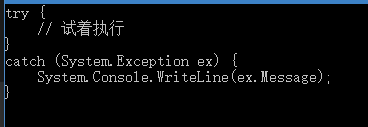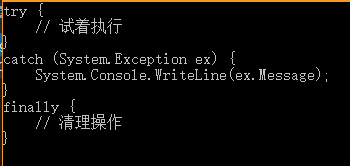写完这一篇,大概可以准备过年了,就算是这系列文章的收尾吧。
异常处理语句,就是常说的try…catch语句,有时候,也会带有finally子句。要生成异常处理语句,得用到CodeTryCatchFinallyStatement类,它包含三个部分。
1、TryStatements:尝试执行的代码块。
2、CatchClauses:捕捉异常的代码块。CatchClauses是一个子句集合,因为一个try语句可以包含N个catch子句,而每个catch块都由CodeCatchClause类来表示,使用时应提供要捕捉的异常的类型,异常对象的临时变量名,以及catch块的语句集合。
3、FinallyStatements:finally语句块,不管会不会发生异常,finally中的语句会执行。
下面看一个最常见的try语句的生成。
CodeTryCatchFinallyStatement trycatfanStatement = new CodeTryCatchFinallyStatement();trycatfanStatement.TryStatements.Add(new CodeCommentStatement("试着执行"));CodeCatchClause catClause = new CodeCatchClause();// 异常类型catClause.CatchExceptionType = new CodeTypeReference(typeof(Exception));// 临时变量名catClause.LocalName = "ex";// catch块中的语句catClause.Statements.Add(new CodeMethodInvokeExpression(new CodeMethodReferenceExpression(new CodeTypeReferenceExpression(typeof(Console)), nameof(Console.WriteLine)), new CodePropertyReferenceExpression(new CodeVariableReferenceExpression("ex"), nameof(Exception.Message))));// 记得将 CodeCatchClause 对象加入到 CatchClauses 集合中trycatfanStatement.CatchClauses.Add(catClause);CodeDomProvider provider = CodeDomProvider.CreateProvider("cs");provider.GenerateCodeFromStatement(trycatfanStatement, Console.Out, null);
以上代码只生成了try和catch两个子块,这种形式是最为常见的。其生成的代码如下。
当然,如果需要,还可以添加上 finally 块,在上面的示例代码中加入以下代码:
trycatfanStatement.FinallyStatements.Add(new CodeCommentStatement("清理操作"));
然后生成的代码中就会包含 finally 块了。
try 语句可以包括多个 catch 子句,比如这样。
CodeTryCatchFinallyStatement trystatement = new CodeTryCatchFinallyStatement();trystatement.TryStatements.Add(new CodeCommentStatement("待执行代码"));// 第一个 catch 子句CodeCatchClause catch1 = new CodeCatchClause();catch1.CatchExceptionType = new CodeTypeReference(typeof(FormatException));catch1.LocalName = "fex";catch1.Statements.Add(new CodeCommentStatement("捕捉异常"));trystatement.CatchClauses.Add(catch1);// 第二个 catch 子句CodeCatchClause catch2 = new CodeCatchClause();catch2.CatchExceptionType = new CodeTypeReference(typeof(ArgumentException));catch2.LocalName = "gex";catch2.Statements.Add(new CodeCommentStatement("捕捉异常"));trystatement.CatchClauses.Add(catch2);CodeDomProvider p = CodeDomProvider.CreateProvider("C#");p.GenerateCodeFromStatement(trystatement, Console.Out, null);
以上代码生成的try语句包含两个catch子句,分别捕捉FormatException和ArgumentException两种类型的异常。生成的代码如下。
顺便也说说抛出异常的语句,使用的是 CodeThrowExceptionStatement 类,例如
CodeThrowExceptionStatement ts = new CodeThrowExceptionStatement(new CodeObjectCreateExpression(typeof(FieldAccessException)));
生成的throw语句如下图所示。
传递给 CodeThrowExceptionStatement 构造函数的参数为要抛出的异常对象,本例直接用new关键字来创建异常实例。如果明确定义了异常变量,可以引用变量。就像这样。
CodeVariableDeclarationStatement vd = new CodeVariableDeclarationStatement(typeof(EncoderFallbackException), "ex", new CodeObjectCreateExpression(typeof(EncoderFallbackException)));CodeThrowExceptionStatement ts = new CodeThrowExceptionStatement(new CodeVariableReferenceExpression("ex"));CodeDomProvider p = CodeDomProvider.CreateProvider("cs");p.GenerateCodeFromStatement(vd, Console.Out, null);p.GenerateCodeFromStatement(ts, Console.Out, null);
生成的代码如下。
===========================================
好了,Code DOM 系列文章就写完了。

